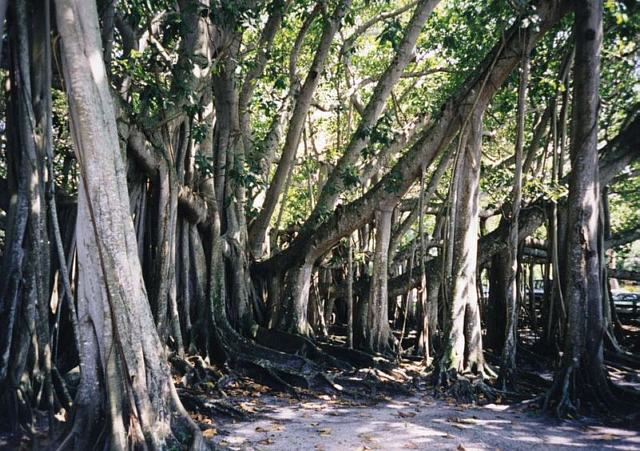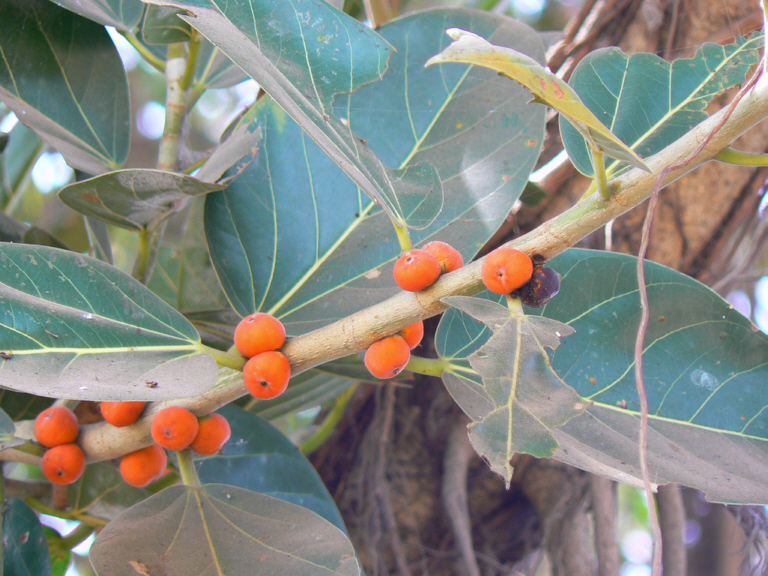

Zitierweise / cite as:
Carakasaṃhitā: Ausgewählte Texte aus der Carakasaṃhitā / übersetzt und erläutert von Alois Payer <1944 - >. -- Anhang A: Pflanzenbeschreibungen. -- Ficus benghalensis L. -- Fassung vom 2007-06-29. -- URL: http://www.payer.de/ayurveda/pflanzen/ficus_benghalensis.htm
Erstmals publiziert: 2007-06-27
Überarbeitungen: 2007-06-29 [Ergänzungen]
Anlass: Lehrveranstaltung SS 2007
©opyright: Dieser Text steht der Allgemeinheit zur Verfügung. Eine Verwertung in Publikationen, die über übliche Zitate hinausgeht, bedarf der ausdrücklichen Genehmigung des Verfassers
Dieser Text ist Teil der Abteilung Sanskrit von Tüpfli's Global Village Library
WARNUNG: dies ist der Versuch einer
Übersetzung und Interpretation eines altindischen Textes. Es ist keine
medizinische Anleitung. Vor dem Gebrauch aller hier genannten Heilmittel wird
darum ausdrücklich gewarnt. Nur ein erfahrener, gut ausgebildeter ayurvedischer
Arzt kann Verschreibungen und Behandlungen machen!
Falls Sie die diakritischen Zeichen nicht dargestellt bekommen, installieren Sie eine Schrift mit Diakritika wie z.B. Tahoma.
Verwendete und zitierte Werke siehe: http://www.payer.de/ayurveda/caraka0001.htm

Abb.: Ficus benghalensis L.
— Banyan-Feige
[Bildquelle: Wikipedia]

Abb.: Ficus benghalensis L.
— Banyan-Feige
[Bildquelle:
dinesh_valke. --
http://www.flickr.com/photos/dinesh_valke/421280398/. -- Zugriff am
2007-06-29. --
![]()
![]()
![]() Creative
Commons Lizenz (Namensnennung, keine kommerzielle Nutzung, keine Bearbeitung)]
Creative
Commons Lizenz (Namensnennung, keine kommerzielle Nutzung, keine Bearbeitung)]
Drury:
"Ficus Bengalensis (Linn.) N. O. Moraceae.
- Common Banyan tree Eng.,
- Ala-maum, Tam.
- Bur, But, Beng.
- Marri, Tel.
Description.—Tree ; branches spreading very much; lower ones rooting; leaves alternate, ovate, bluntly acuminated, with parallel nerves, paler underneath, entire, downy when young afterwards smooth; fruit-receptacles axillary, paired, sessile as large as a middle-sized cherry, appearing and ripening in the hot season.— Wight Icon. t. 1989.—F. Indica, Roxb. Fl. Ind. iii. 539.—Urostigma Bengalense, Miquel.—Rheede, I t. 28.------Common everywhere.
Medical Uses.—The seeds of the fruit are considered as cooling and tonic, being prescribed in the form of electuary. The white glutinous juice which flows from the stems is applied as a remedy in toothache, and also to the soles of the feet when cracked and inflamed. The bark given in infusion is said to be a tonic, and is also used in diabetes. —Ainslie.
Economic Uses.—There are several species as well as varieties of the Banyan-tree which throw out roots from their branches. The present one may perhaps be considered the best type of the family. It is remarkable, as every one knows, for the singular property of letting a gummy kind of rootlet fall from its branches. These on reaching the ground soon form a natural support to the larger branches of the parent tree, and several of these extending and increasing from year to year, forming a vast assemblage of pillar-like stems, cover a considerable area round the original trunk,—"Branching be broad and long that in the ground The bending twigs take root, and daughters grow About the mother tree, a pillared shade-High over-arched with echoing walks between."
Many instances are on record of the immense extent of some of these trees, which form so peculiar a feature in an Oriental landscape. One tree of the kind near Fort St David was computed to cover nearly 1700 yards. Colonel Sykes mentions one at Mhow with 68 stems descending from the branches, and capable of affording a shade under a vertical sun to 20,000 men. Roxburgh says that he has seen such trees fully 500 yards round the circumference of the branches and 100 feet high, the principal trunk being more than 25 feet to the branches, and 8 or 9 feet in diameter. Travellers in this country have described them large enough to shelter a regiment of cavalry, and how they have formed a natural canopy for public meetings and other assemblages. The ancients were acquainted with the tree, and both Strabo and Pliny have accurately, described it. The wood is of no value, being light and porous. The Brahmins use the leaves as plates to eat off. Bird-lime is manufactured from the milky juice which abounde in every part of the tree. If the seeds drop into the axils of the leaves of the palmyra-tree, the roots grow downwards embracing the trunk in their descent, until by degrees they envelop every part except the top. In very old specimens the leaves and head of the palmyra are seen emerging from the trunk of the Banyan-tree, as if they grew from it. These the Hindoos regard with reverence, and call them holy marriages.— Roxb."
[Quelle: Drury, Heber <1819 - 1872>: The useful plants of India : with notices of their chief value in commerce, medicine, and the arts. -- 2d ed. with additions and corrections. London : Allen, 1873. -- xvi, 512 p. ; 22 cm. -- s.v.]
Dutt:
"FICUS RELIGIOSA, Linn. Sans. Asvattha. Vern. Pipal, Hind. FICUS BENGALENSIS, Linn. Sans. Vata. Vern. Bar. Hind,
FICUS GLOMERATA, Willd. Sans, Udumbara. Vern. Jagnodumar, Beng. Gular, Hind.
FICUS INFECTORIA, Roxb, Sans. Parkati. Vern. Pākur, Beng. Pākri, Hind.
The root-barks of these four species of Ficus together with that of Azadarachta lndica pass by the name of Panchavalkala or the five barks, and are used in combination. A decoction of these barks, called Pancha valkala kashāya is much used as a gargle in salivation, as a wash for ulcers, and as an injection in leucorrhoea. The powdered root-bark of Ficus religiosa rubbed with honey is applied to aphthous sores of children. It is also sprinkled over " unhealthy ulcers to improve their condition and promote granulation.
The figs of Ficus glomerata are considered astringent, stomachic and carminative and are given in menorrhagia and haemoptysis in doses of one tola of the dried fruits with sugar and honey. The fresh juice of the ripe fruit is given as an adjunct to a metallic medicine for diabetes and other urinary complaints, called Vrihat vangesvara rasa, (see Tin)."
[Quelle: Dutt, Uday Chand: The materia medica of the Hindus / Uday Chand Dutt. With a glossary of Indian plants by George King. -- 2. ed. with additions and alterations / by Binod Lall Sen & Ashutosh Sen. -- Calcutta, 1900. - XVIII, 356 S. -- S. 235.]